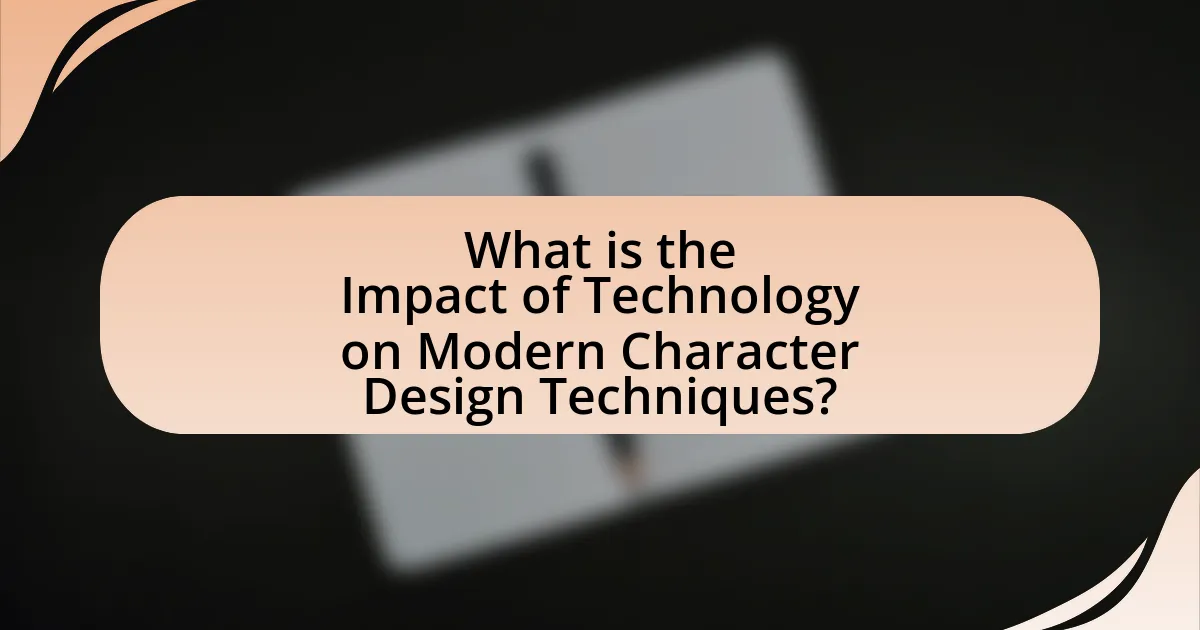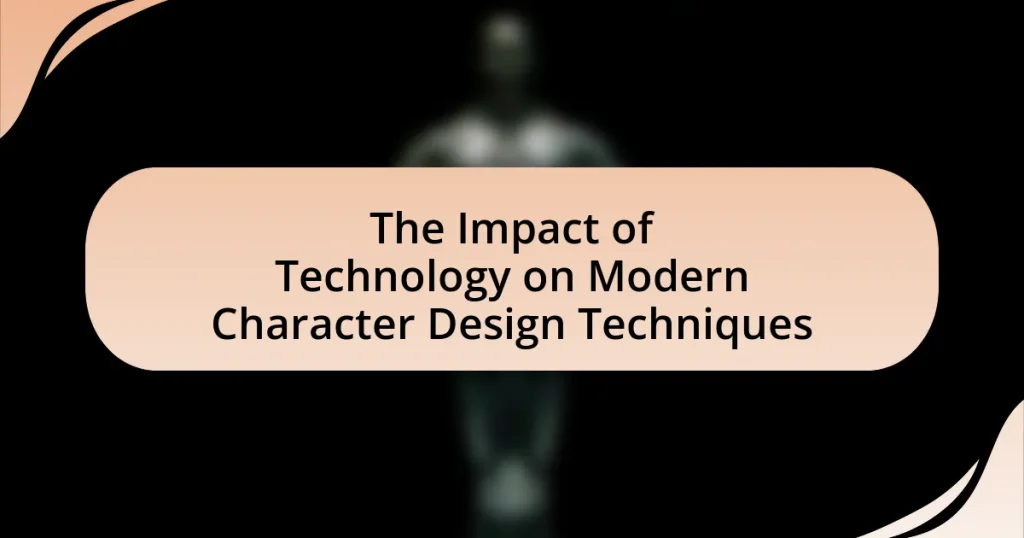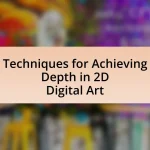The article examines the significant impact of technology on modern character design techniques, highlighting how advanced software and tools have transformed the creative process. It discusses the role of digital art programs, 3D modeling software, motion capture, and artificial intelligence in enhancing character design efficiency and creativity. Key technologies such as Autodesk Maya, Blender, and Adobe Photoshop are explored, along with their influence on traditional methods and current trends in character design. The article also addresses the challenges designers face with rapid technological advancements and offers practical tips for effectively integrating these tools into their workflows.

What is the Impact of Technology on Modern Character Design Techniques?
The impact of technology on modern character design techniques is profound, as it has revolutionized the creative process through advanced software and tools. Digital art programs like Adobe Photoshop and 3D modeling software such as Blender enable artists to create intricate designs with precision and efficiency. Additionally, technologies like motion capture and virtual reality allow for more realistic character animations and interactions, enhancing the overall storytelling experience. The integration of artificial intelligence in design tools further streamlines workflows, providing artists with intelligent suggestions and automating repetitive tasks. These advancements not only increase productivity but also expand the creative possibilities for character designers, allowing for more innovative and diverse character representations in various media.
How has technology transformed traditional character design methods?
Technology has significantly transformed traditional character design methods by introducing digital tools that enhance creativity and efficiency. Digital software such as Adobe Photoshop and 3D modeling programs like Blender allow artists to create intricate designs with precision and speed, reducing the time required for manual sketching and painting. Additionally, advancements in hardware, such as graphic tablets and styluses, enable artists to draw directly onto screens, mimicking traditional techniques while benefiting from digital capabilities. The integration of artificial intelligence in design processes also streamlines character creation, offering automated suggestions and variations that can inspire new ideas. These technological innovations have led to a more dynamic and versatile approach to character design, allowing for greater experimentation and collaboration across different media.
What specific technologies have influenced character design?
3D modeling software, such as Autodesk Maya and Blender, has significantly influenced character design by enabling artists to create detailed and complex character models. These tools allow for precise manipulation of geometry, textures, and rigging, facilitating the development of lifelike characters in animation and gaming. Additionally, motion capture technology has transformed character animation by capturing real human movements, which can be applied to digital characters, enhancing realism. Furthermore, virtual reality (VR) and augmented reality (AR) technologies have opened new avenues for character interaction and design, allowing designers to visualize and test characters in immersive environments. These advancements collectively demonstrate how specific technologies have reshaped the character design landscape, making it more dynamic and realistic.
How do digital tools enhance the character design process?
Digital tools significantly enhance the character design process by providing artists with advanced capabilities for visualization, iteration, and collaboration. These tools, such as 3D modeling software and digital painting applications, allow designers to create detailed and dynamic character models quickly, facilitating rapid prototyping and adjustments. For instance, software like Adobe Photoshop and Blender enables artists to manipulate textures, colors, and shapes in real-time, which streamlines the workflow and fosters creativity. Additionally, digital platforms support collaborative efforts, allowing multiple designers to work on a character simultaneously, thus improving efficiency and innovation in character development.
What role does software play in modern character design?
Software plays a crucial role in modern character design by enabling artists to create, manipulate, and visualize characters with precision and efficiency. Advanced software tools such as Adobe Photoshop, Autodesk Maya, and Blender provide features like 3D modeling, texturing, and rigging, which streamline the design process and enhance creativity. For instance, the use of 3D modeling software allows designers to visualize characters from multiple angles and make real-time adjustments, significantly reducing the time required for revisions. Additionally, software facilitates collaboration among teams, as assets can be easily shared and modified across different platforms. This integration of technology not only improves the quality of character designs but also expands the possibilities for animation and interactive media, reflecting the evolving demands of the industry.
Which software applications are most popular among character designers?
The most popular software applications among character designers are Adobe Photoshop, Autodesk Maya, and Blender. Adobe Photoshop is widely used for 2D character design and concept art due to its extensive painting and editing tools. Autodesk Maya is favored for 3D modeling and animation, providing robust features for character rigging and skinning. Blender has gained popularity for its open-source nature and comprehensive suite of modeling, sculpting, and animation tools, making it accessible for both beginners and professionals. These applications are integral to the character design process, enabling designers to create detailed and dynamic characters efficiently.
How do these applications improve efficiency and creativity?
Applications improve efficiency and creativity in character design by automating repetitive tasks and providing advanced tools for ideation. Automation allows designers to focus on high-level creative decisions rather than mundane processes, significantly reducing time spent on tasks like rendering and asset management. For instance, software like Adobe Character Animator uses motion capture to streamline animation, enabling quicker iterations and more dynamic character movements. Additionally, tools such as Procreate and Blender offer features like layering and 3D modeling, which enhance creative possibilities by allowing designers to experiment with various styles and techniques rapidly. This combination of automation and advanced functionality leads to a more efficient workflow and fosters greater creativity in character design.
What are the implications of 3D modeling in character design?
3D modeling significantly enhances character design by allowing for greater detail, realism, and flexibility in the creation process. This technology enables designers to visualize characters in three dimensions, facilitating intricate textures, accurate proportions, and dynamic poses that are difficult to achieve with traditional methods. For instance, the use of software like Blender or Maya allows artists to manipulate models in real-time, making adjustments that can lead to more lifelike and engaging characters. Additionally, 3D modeling supports animation by providing a solid framework for rigging and movement, which is essential in industries such as gaming and film. The implications of this technology are evident in the increasing demand for high-quality, visually compelling characters that resonate with audiences, as seen in successful franchises like Pixar and Marvel, where 3D character design plays a pivotal role in storytelling and audience engagement.
How does 3D modeling differ from traditional 2D techniques?
3D modeling differs from traditional 2D techniques primarily in its dimensionality, allowing for the creation of objects with depth and volume, whereas 2D techniques are limited to height and width. In 3D modeling, artists manipulate geometric shapes in a three-dimensional space, enabling realistic representations and animations, which are not possible in 2D. For instance, 3D models can be rotated and viewed from multiple angles, providing a more immersive experience. In contrast, 2D art relies on flat images, which can lack the depth and realism that 3D models offer. This fundamental difference enhances character design by allowing for more complex and lifelike representations, as seen in modern video games and animated films where 3D characters interact within a three-dimensional environment.
What advantages does 3D modeling offer for character animation?
3D modeling offers significant advantages for character animation, primarily through enhanced realism and flexibility. The use of 3D modeling allows animators to create detailed and lifelike characters with intricate textures and movements that mimic real-life physics. This technology enables the manipulation of characters in a virtual space, allowing for a wide range of poses and expressions without the limitations of traditional 2D animation. Additionally, 3D models can be easily modified and reused, streamlining the animation process and reducing production time. The integration of rigging techniques further enhances this flexibility, allowing for complex animations that can be adjusted quickly. These advantages are supported by industry practices, where studios like Pixar and DreamWorks utilize 3D modeling to produce high-quality animated films, demonstrating its effectiveness in achieving visually stunning results.
How does technology influence character design trends?
Technology significantly influences character design trends by enabling more sophisticated tools and techniques for artists. Advanced software like Adobe Creative Suite and 3D modeling programs such as Blender allow for intricate designs and rapid prototyping, which enhances creativity and efficiency. Furthermore, the rise of artificial intelligence in design processes, such as AI-assisted character generation, streamlines workflows and introduces innovative styles that reflect contemporary aesthetics. For instance, the use of motion capture technology in video games and films has led to more realistic character animations, shaping audience expectations and industry standards. This evolution in technology not only alters the visual aspects of character design but also impacts narrative and emotional engagement, as seen in popular franchises like “The Last of Us” and “Spider-Man: Into the Spider-Verse,” where character depth is enhanced through technological advancements.
What current trends in character design are driven by technological advancements?
Current trends in character design driven by technological advancements include the use of 3D modeling software, augmented reality (AR), and artificial intelligence (AI). 3D modeling software, such as Blender and ZBrush, allows designers to create highly detailed and realistic characters, enhancing visual storytelling in games and films. Augmented reality enables interactive character experiences, allowing users to engage with characters in real-world environments, as seen in applications like Pokémon GO. Additionally, AI tools streamline the design process by generating character concepts and animations, significantly reducing production time. These advancements reflect a shift towards more immersive and efficient character design practices in the industry.
How do social media and online platforms affect character design popularity?
Social media and online platforms significantly enhance character design popularity by providing creators with immediate access to a global audience. These platforms facilitate the sharing of artwork, allowing designers to showcase their characters to millions, which can lead to viral trends and increased visibility. For instance, platforms like Instagram and TikTok have algorithms that promote engaging content, enabling character designs to gain traction quickly. Additionally, user interaction through likes, shares, and comments can influence the popularity of specific designs, as seen in the rise of fan art and character reinterpretations that often gain substantial followings. This dynamic interaction creates a feedback loop where popular designs can inspire further creativity and innovation within the community, ultimately shaping trends in character design.
What challenges do designers face with technological advancements?
Designers face several challenges with technological advancements, including the rapid pace of change, the need for continuous learning, and the integration of new tools into existing workflows. The rapid evolution of software and hardware can lead to a skills gap, as designers must constantly update their knowledge to stay relevant. For instance, a survey by the Design Council found that 70% of designers feel pressured to learn new technologies quickly to meet industry demands. Additionally, integrating new technologies can disrupt established processes, requiring designers to adapt their creative workflows, which can hinder productivity and creativity.
How do rapid technological changes impact skill development for designers?
Rapid technological changes significantly enhance skill development for designers by necessitating continuous learning and adaptation to new tools and methodologies. As technology evolves, designers must acquire proficiency in advanced software, such as 3D modeling programs and digital illustration tools, which are increasingly integral to modern design processes. For instance, the rise of virtual reality and augmented reality in design requires designers to learn new skills related to immersive environments, thereby expanding their creative capabilities. Furthermore, studies indicate that 70% of designers report needing to update their skills regularly to keep pace with industry standards, highlighting the direct correlation between technological advancements and the demand for ongoing professional development.
What are the common pitfalls in adopting new technologies for character design?
Common pitfalls in adopting new technologies for character design include over-reliance on software, inadequate training, and neglecting traditional skills. Over-reliance on software can lead to a lack of originality, as designers may default to templates or presets instead of creating unique characters. Inadequate training can result in inefficient use of tools, causing frustration and wasted resources; for instance, a study by the International Journal of Art and Design Education highlights that designers who lack proper training often produce lower-quality work. Lastly, neglecting traditional skills, such as drawing and sculpting, can diminish a designer’s ability to conceptualize and iterate effectively, as evidenced by industry feedback indicating that foundational skills remain crucial even in a digital landscape.
How can designers effectively integrate technology into their workflow?
Designers can effectively integrate technology into their workflow by utilizing digital tools and software that enhance creativity and efficiency. For instance, software like Adobe Creative Suite allows designers to create and manipulate graphics with precision, while 3D modeling tools such as Blender enable the visualization of character designs in a three-dimensional space. Additionally, project management platforms like Trello or Asana streamline collaboration among team members, ensuring that feedback and revisions are efficiently managed. Research indicates that the use of technology in design can reduce project timelines by up to 30%, demonstrating its significant impact on productivity and workflow optimization.
What best practices should designers follow when using new tools?
Designers should prioritize user training and exploration when using new tools. Familiarizing themselves with the tool’s features through tutorials or documentation enhances their efficiency and creativity. Research indicates that 70% of users who engage in comprehensive training report increased productivity and satisfaction with new software (Source: TechSmith, “The Impact of Training on Software Adoption,” 2021). Additionally, designers should integrate feedback loops by sharing their experiences with peers, which fosters collaborative learning and innovation. This practice not only improves individual skill sets but also contributes to a collective knowledge base within design teams.
How can collaboration tools enhance the character design process?
Collaboration tools enhance the character design process by facilitating real-time communication and feedback among team members. These tools enable designers to share ideas, sketches, and revisions instantly, which accelerates the creative workflow. For instance, platforms like Figma and Miro allow multiple users to collaborate on designs simultaneously, leading to a more dynamic and iterative design process. Research indicates that teams using collaborative software can increase productivity by up to 30%, as they reduce the time spent on revisions and approvals. This efficiency ultimately leads to more refined character designs that better align with the project’s vision.
What future trends can we expect in character design due to technology?
Future trends in character design due to technology include increased use of artificial intelligence, augmented reality, and real-time rendering. Artificial intelligence will enable designers to generate complex character models and animations more efficiently, as seen in tools like NVIDIA’s GauGAN, which allows for rapid creation of realistic environments and characters. Augmented reality will enhance character interaction in gaming and virtual experiences, allowing users to engage with characters in their real-world environments. Real-time rendering technologies, such as Unreal Engine’s advancements, will facilitate high-quality visuals and immediate feedback during the design process, streamlining workflows and enhancing creativity. These trends indicate a shift towards more immersive and interactive character design experiences.
How might artificial intelligence shape the future of character design?
Artificial intelligence will significantly shape the future of character design by automating and enhancing the creative process. AI tools can analyze vast datasets of existing character designs, enabling designers to generate unique concepts quickly and efficiently. For instance, AI algorithms can identify trends and preferences in character aesthetics, allowing for designs that resonate more with target audiences. Additionally, AI-driven software can assist in creating detailed textures, animations, and even voice synthesis, streamlining production workflows. The integration of AI in character design is already evident in projects like Disney’s use of machine learning to develop character animations, demonstrating its potential to revolutionize the industry.
What emerging technologies should designers keep an eye on?
Designers should keep an eye on artificial intelligence, augmented reality, and virtual reality as emerging technologies. Artificial intelligence is transforming design processes through tools that automate repetitive tasks and enhance creativity, such as generative design software that can produce multiple design variations based on specific parameters. Augmented reality allows designers to create immersive experiences by overlaying digital elements onto the real world, which is particularly useful in character design for games and interactive media. Virtual reality offers a fully immersive environment for designers to visualize and interact with their creations, enabling more intuitive design processes and user testing. These technologies are reshaping the landscape of character design, making it essential for designers to stay informed about their developments and applications.
What practical tips can enhance character design using technology?
Utilizing technology can significantly enhance character design through several practical tips. First, employing 3D modeling software like Blender or ZBrush allows designers to create detailed and dynamic character models, facilitating a more realistic representation. Additionally, using digital painting tools such as Adobe Photoshop or Procreate enables artists to experiment with color palettes and textures efficiently, leading to more visually appealing designs.
Moreover, incorporating motion capture technology can provide realistic animations, enhancing the character’s expressiveness and movement. Utilizing AI-driven tools for generating character concepts can also streamline the design process, allowing for rapid iterations and creative exploration. These methods are supported by industry practices, as many successful game and animation studios leverage these technologies to produce high-quality character designs.


